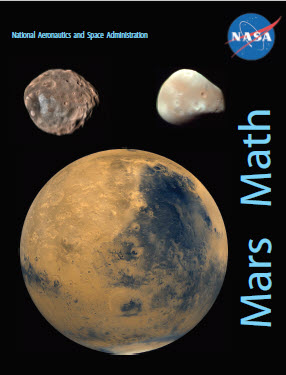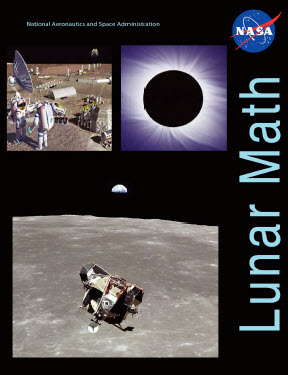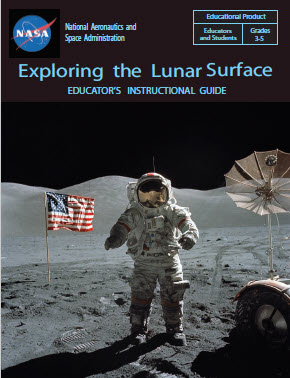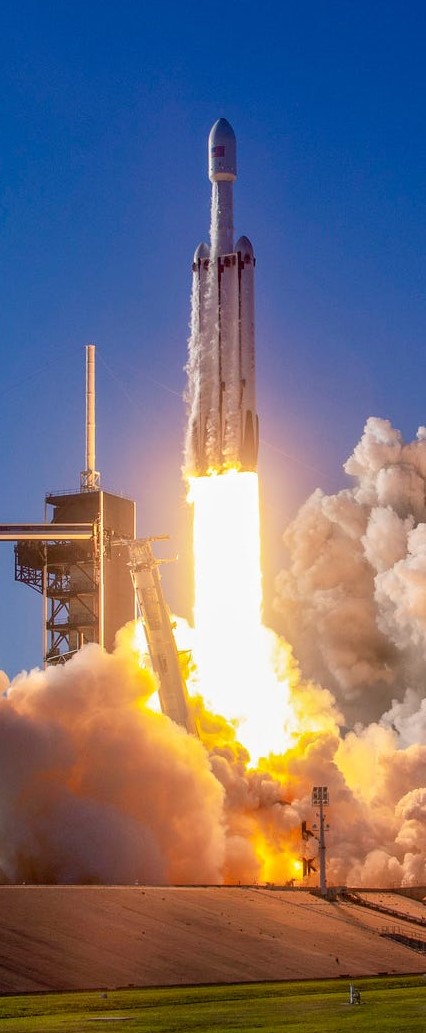Math problems about Space Travel
Problem 472: Investigating Juno's Elliptical Transfer Orbit
Students use the Standard Formula for an ellipse to study the elliptical orbit of the Juno spacecraft, and relate specific properties of the
ellipse to features of the spacecrafts trajectory such as aphelion, perihelion, and ellipticity.
[Grade: 9-12 | Topics: formula for an ellipse; semi-major and minor axis]
[Click here]
Problem 471: Investigating the Launch of the Juno Spacecraft
Students use a series of images from a launch video to determine the scale of each image and
determine the speed of the rocket as it leaves the gantry.
[Grade: 6-8 | Topics: scale models; speed = distance/times]
[Click here]
Problem 470: The Launch of the Juno Spacecraft - Ascent to orbit
Students use tabulated altitude and range data following the launch of the Juno mission, to determine the speed of the rocket as it travels from the ground to earth orbit.
[Grade: 6-8 | Topics: scale models; speed = distance/time]
[Click here]
Problem 469: Solar Energy and the Distance of Juno from the Sun
Students use the formula for an ellipse, along with the inverse-square law to create a mathematical model that predicts
the declining solar power produced by Junos solar panels as the spacecraft travels from Earth to Jupiter.
[Grade: 9-12 | Topics: algebra; trigonometry; distance formula]
[Click here]
Problem 457: The Interplanetary Voyage of MSL
Students use the properties of ellipses to determine the formula for the Hohmann Transfer Orbit taking the Mars Science Laboratory to Mars in 2012
[Grade: 10-11 | Topics: time=distance/speed; scale models; metric math; properties of ellipses]
[Click here]
Problem 456: The Launch of the Mars Science Laboratory (MSL) in 2011
Students use a sequence of launch images to determine the Atlas V's launch speed and acceleration. By determining the scale of each image, they estimate average speeds during the first 4 seconds after lift-off.
[Grade: 8-10 | Topics: time=distance/speed; scale models; metric math]
[Click here]
Problem 455: The Night Launch of STEREO in 2006
An example of old news seen in a different way! Students use a spectacular time-lapse photo of the launch of the STEREO mission obtained by photographer Dominic Agostini in 2006 to study parabolic curves.
[Grade: 8-10 | Topics: time=distance/speed; scale models; metric math; equation of a parabola; curve fitting]
[Click here]
Problem 419: The Space Shuttle: Fly me to the moon? Students discuss the popular misconception that the Space Shuttle can travel to the moon by examining the required orbit speed change and the capacity of the Shuttle engines to provide the necessary speed changes. [Grade: 6-8 | Topics: amount = rate x time ] [Click here]
Problem 324: Deep Impact Comet Flyby The Deep Impact spacecraft flew by the Comet Tempel-1 in 2005. Students determine the form of a function that predicts the changing apparent size of the comet as viewed from the spacecraft along its trajectory. [Grade: 9-12 | Topics: Algebra, geometry, differential calculus] [Click here]
Problem 316: Counting Craters on the Hubble Space Telescope Students count craters on a piece of the Wide Field Planetary Camera recovered from the Hubble Space Telescope in 2009. They determine the cratering rate and use this to predict how many impacts the solar panels on the International Space Station experiences each day. [Grade: 6-9 | Topics: Counting; Area; density] [Click here]
Problem 282: Exploring the Ares 1-X Launch: The Hard Climb to Orbit Students learn about the energy required to send a payload into orbit by studying the Ares 1-X rocket launch. [Grade: 8-10 | Topics: Algebra II] [Click here]
Problem 281: Exploring the Ares 1-X Launch: Energy Changes Students learn about kinetic and potential energy while studying the Ares 1-X rocket launch. [Grade: 8-10 | Topics: Algebra II] [Click here]
Problem 280: Exploring the Ares 1-X Launch: Parametrics Students learn about parametric equations to determine the path of the Ares 1-X rocket. [Grade: 8-10 | Topics: Algebra II; Parametric Equations] [Click here]
Problem 279: Exploring the Ares 1-X Launch: Downrange Distance Students learn about the path of the Ares 1-X test launch and calculate its downrange landing distance in the Atlantic Ocean. [Grade: 8-10 | Topics: Algebra; Significant Figures; Metric to English Conversion] [Click here]
Problem 276: Solid Rocket Boosters and Thrust Students learn how solid rocket boosters work, and calculate the SRB Thrust Curve using a simple geometric model and 'counting squares'. [Grade: 8-10 | Topics: Geometry, Cylindrical volumes and surface areas, Graphing data] [Click here]
Problem 266: The Ares-V Cargo Rocket Students work with the equations for thrust and fuel loss to determine the acceleration curve of the Ares-v during launch. [Grade: 11-12 | Topics: Algebra II, properties of functions, differential calculus, Excel Spreadsheet] [Click here]
Problem 260: Some Famous Unit Conversion Errors Students examine three famous unit conversion errors that led to catastrophic failures and near-death experiences. [Grade: 6-8 | Topics: unit conversion, metric measure] [Click here]
Problem 245: Solid Rocket Boosters Students learn how SRBs actually create thrust, and study the Ares-V booster to estimate its thrust. [Grade: 8-10 | Topics: volume, area, unit conversions] [Click here]
Problem 243: ISS - Orbit Altitude Changes Students read an essay describing the increases and decreases in the International Space Station orbit, and calculate the final orbit altitude after all the changes are applied. [Grade: 8-10 | Topics: combining positive and negative mixed numbers; fractions] [Click here]
Problem 238: Satellite Drag and the Hubble Space Telescope Satellite experience drag with the atmosphere, which eventually causes them to burn up in the atmosphere. Students study various forecasts of the althtiude of the Hubble Space Telescope to estimate its re-entry year. [Grade: 8-10 | Topics: interpreting graphical data; predicting trends] [Click here]
Problem 210: The Mathematics of Ion Rocket Engines- Students learn about the basic physics of ion engines, calculating speeds. [Grade: 9-12| Topics: Scientific Notation; Algebra II; evaluating formulae.] [Click here]
Problem 206: Can You Hear me now? - Students learn about how the transmission of data is affected by how far away a satellite is, for a variety of spacecraft in the solar system [Grade: 6-8| Topics: multiplication; division; decimal numbers.] [Click here]
Problem 203: Light Travel Times- Students determine the time it takes light to reach various objects in space. [Grade: 6-8| Topics: Scientific Notation; Multiplication; time = distance/speed.] [Click here]
Problem 202: The Dawn Mission - Ion Rockets and Spiral Orbits- Students determine the shape of the trajectory taken by a spacecraft using a constant-thrust ion motor using differential and integral calculus for arc lengths. [Grade: 9-12| Topics: Calculus - Arc lengths.] [Click here]
Problem 201: Fly Me To the Moon!- Students learn some basic principles and terminology about how spacecraft change their orbits to get to the moon. [Grade: 6-8| Topics: speed = distance/time; Pythagorean Theorem] [Click here]
Problem 185: The International Space Station: Follow that graph!- Students use a plot of the orbit altitude of the ISS to predict its re-entry year after the peak of the next solar activity cycle. [Grade: 6-8| Topics: extrapolating a simple graph; estimation; forecasting] [Click here]
Problem 181: Extracting Oxygen from Moon Rocks- Students use a chemical equation to estimate how much oxygen can be liberated from a sample of lunar soil. [Grade: 9-11| Topics: ratios; scientific notation; unit conversions] [Click here]
Problem 179: Is There a Lunar Meteorite Impact Hazard? - Students work with areas, probability and impact rates to estimate whether lunar colonists are in danger of meteorite hazards. [Grade: 5-7| Topics: Area; unit conversions; rates] [Click here]
Problem 166: The Dollars and Cents of Research - Students work with dollar amounts, hourly salary rates, percentages to explore various models of the cost of scientific research as seen by the individual scientist. [Grade: 4-6 | Topics: percentages, decimal math, simple rates (e.g dollars/hour)] [Click here]
Problem 157: Space Shuttle Launch Trajectory - I - Students use the parametric equation for the altitude and range for an actual Shuttle launch to determine the speed and acceleration of the Shuttle during launch and orbit insertion. [Grade: 11-12 | Topics: Algebra; Calculus; Parametric Equations; Differentiation] [Click here]
Problem 133 How Big is It? - The Mars Rover. Students work with an image taken by the Mars Orbiter satellite of the Spirit landing site. They determine the image scale, and calculate the sizes of various surface features from the image. [Grade: 4 - 7 | Topics:image scaling; multiply, divide, work with millimeter ruler] [Click here]
Problem 121 Ice on Mercury? Since the 1990's, radio astronomers have mapped Mercury. An outstanding curiosity is that in the polar regions, some craters appear to have 'anomalous reflectivity' in the shadowed areas of these craters. One interpretation is that this is caused by sub-surface ice. The MESSENGER spacecraft hopes to explore this issue in the next few years. In this activity, students will measure the surface areas of these potential ice deposits an calculate the volume of water that they imply. [Grade: 8-10 | Topics:Area of a circle; volume, density, unit conversion] [Click here]
Problem 113 NASA Juggles Four Satellites at Once! Students will learn about NASA's Magnetospheric Multi-Scale (MMS) satellite mission, and how it will use four satellites flying in formation to investigate the mysterious process called Magnetic Reconnection that causes changes in Earth's magnetic field. These changes lead to the production of the Northern and Southern Lights and other phenomena. From the volume formula for a tetrahedron, they will calculate the volume of several satellite configurations and estimate the magnetic energy and travel times for the particles being studied by MMS. [Grade: 8-10 | Topics: Formulas with two variables; scientific notation] [Click here]
Problem 108 A Problem in Satellite Synchrony The THEMIS program uses five satellites in five different orbits to study Earth's magnetic field and its changes during a storm. This problem asks students to use the periods of the five satellites to figure out when all 5 satellites will be lined-up as seen from Earth. They will do this by finding the Greatest Common Multiple of the five orbit periods, first for the case of 2 or 3 satellites, which can be easily diagrammed with concentric circles, then the case for all five satellites together. [Grade: 5-9 | Topics:multiplication; Greatest Common Multiple] [Click here]
Problem 96 Hinode Satellite Power - Students will study the design of the Hinode solar satellite and calculate how much power it can generate from its solar panels. [Grade level: 6-8 | Topics:area of rectangle,area of cylinder, unit conversion] [Click here]
Problem 95 A Study on Astronaut Radiation Dosages in Space - Students will examine a graph of the astronaut radiation dosages for Space Shuttle flights, and estimate the total dosages for astronauts working on the International Space Station. [Grade level: 9-11 | Topics:Graph analysis, interpolation, unit conversion] [Click here]
Problem 93 An Introduction to Radiation Shielding - Students calculate how much shielding a new satellite needs to replace the ISO research satellite. Students use a graph of the wall thickness versus dosage, and determine how thick the walls of a hollow cubical satellite have to be to blackuce the radiation exposure of its electronics. Students calculate the mass of the satellite and the cost savings by using different shielding. [Grade level: 9-11 | Topics: Algebra; Volume of a hollow cube; unit conversion] [Click here]
Problem 89 Atmospheric Shielding from Radiation- III - This is Part III of a 3-part problem on atmospheric shielding. Students use exponential functions to model the density of a planetary atmosphere, then evaluate a definite integral to calculate the total radiation shielding in the zenith (straight overhead) direction for Earth and Mars. [Grade level: 11-12 | Topics: Evaluating an integral, working with exponential functions] [Click here]
Problem 88 Atmospheric Shielding from Radiation- II - This is the second of a three-part problem dealing with atmospheric shielding. Students use the formula they derived in Part I, to calculate the radiation dosage for radiation arriving from directly overhead, and from the horizon. Students also calculate the 'zenith' shielding from the surface of Mars. [Grade level: 9-11 | Topics: Algebra I; evaluating a function for specific values] [Click here]
Problem 87 Atmospheric Shielding from Radiation- I - This is the first part of a three-part problem series that has students calculate how much radiation shielding Earth's atmosphere provides. In this problem, students have to use the relevant geometry in the diagram to determine the algebraic formula for the path length through the atmosphere from a given location and altitude above Earth's surface. [Grade level: 9-11 | Topics: Algebra II, trigonometry] [Click here]
Problem 83 Lunar Meteorite Impact Risks - In 2006, scientists identified 12 flashes of light on the moon that were probably meteorite impacts. They estimated that these meteorites were probably about the size of a grapefruit. How long would lunar colonists have to wait before seeing such a flash within their horizon? Students will use an area and probability calculation to discover the average waiting time. [Grade level: 8-10 | Topics: arithmetic; unit conversions; surface area of a sphere) ] [Click here]
Problem 80 Data Corruption by High Energy Particles - Students will see how solar flares can corrupt satellite data, and create a timeline for a spectacular episode of data loss recorded by the SOHO satellite using images obtained by the satellite. Students will also calculate the speed of the event as particles are ejected from the sun and streak towards earth. [Grade level: 6-8 | Topics: Time and speed calculations; interpreting scientific data ] [Click here]
Problem 79 Correcting Bad Data Using Partity Bits - Students will see how computer data is protected from damage by radiation 'glitches' using a simple error-detection method involving the parity bit. They will reconstruct an uncorrupted sequence of data by checking the '8th bit' to see if the transmitted data word has been corrupted. By comparing copies of the data sent at different times, they will reconstruct the uncorrupted data. [Grade level: 4-6 | Topics: addition, subtraction, comparing the numbers 1 and 0 ] [Click here]
Problem 74 A Hot Time on Mars - The NASA Mars Radiation Environment (MARIE) experiment has created a map of the surface of mars, and measured the ground-level radiation background that astronauts would be exposed to. This math problem lets students examine the total radiation dosage that these explorers would receive on a series of 1000 km journeys across the martian surface. The students will compare this dosage to typical background conditions on earth and in the International Space Station to get a sense of perspective [Grade level: 6-8 | Topics: decimals, unit conversion, graphing and analysis ] [Click here]
Problem 71 Are the Van Allen Belts Really Deadly? - This problem explores the radiation dosages that astronauts would receive as they travel through the van Allen Belts enroute to the Moon. Students will use data to calculate the duration of the trip through the belts, and the total received dosage, and compare this to a lethal dosage to confront a misconception that Apollo astronauts would have instantly died on their trip to the Moon. [Grade level: 8-10 | Topics: decimals, area of rectangle, graph analysis] [Click here]
Problem 70 Calculating Total Radiation Dosages at Mars - This problem uses data from the Mars Radiation Environment Experiment (MARIE) which is orbiting Mars, and measures the daily radiation dosage that an astronaut would experience in orbit around Mars. Students will use actual plotted data to calculate the total dosage by adding up the areas under the data curve. This requires knowledge of the area of a rectangle, and an appreciation of the fact that the product of a rate (rems per day) times the time duration (days) gives a total dose (Rems), much like the product of speed times time gives distance. Both represent the areas under their appropriate curves. Students will calculate the dosages for cosmic radiation and solar proton flares, and decide which component produces the most severe radiation problem. [Grade level: 6-8 | Topics: decimals, area of rectangle, graph analysis] [Click here]
Problem 69 Single Event Upsets in Aircraft Avionics - Radiation is problem for high-altitude commercial and research aircraft. Showers of high-energy neutrons cause glitches in computer electronics and other aircraft systems. This problem investigates the neutron background radiation at 30,000 to 100,000 feet based on actual flight data, and has students calculate how many computer memory glitches will happen over a set amount of flight time. [Grade level: 8-10 | Topics: decimals, unit conversions, graph analysis] [Click here]
Problem 68 An Introduction to Space Radiation - Read about your natural background radiation dosages, learn about Rems and Rads, and the difference between low-level dosages and high-level dosages. Students use basic math operations to calculate total dosages from dosage rates, and calculating cancer risks. [Grade level: 6-8 | Topics: Reading to be Informed; decimals, fractions, square-roots] [Click here]
Problem 66 Background Radiation and Lifestyles - Living on Earth, you will be subjected to many different radiation environments. This problem follows one person through four different possible futures, and compares the cumulative lifetime dosages. [Grade level: 6-8 | Topics: fractions, decimals, unit conversions] [Click here]
Problem 65 A Perspective on Radiation Dosages - Depending on the kind of career you chose, you will experience different lifetime radiation dosages. This problem compares the cumulative dosages for someone living on Earth, an astronaut career involving travel to the Space Station, and the lifetime dosage of someone traveling to Mars and back. [Grade level: 6-8 | Topics: decimals, unit conversions, graphing a timeline, finding areas under curves using rectangles] [Click here]
Problem 36 The Space Station Orbit Decay and Space Weather Students will learn about the continued decay of the orbit of the International Space Station by studying a graph of the Station's altitude versus time. They will calculate the orbit decay rates, and investigate why this might be happening. [Grade: 5 - 8 | Topics: Interpreting graphical data; decimal math] [Click here]
Problem 8 Making a Model Planet Students use the formula for a sphere, and the concept of density, to make a mathematical model of a planet based on its mass, radius and the density of several possible materials (ice, silicate rock, iron, basalt). [Grade: 7 - 9 | Topics: Volume of sphere; mass = density x volume; decimal math; scientific notation] [Click here]






